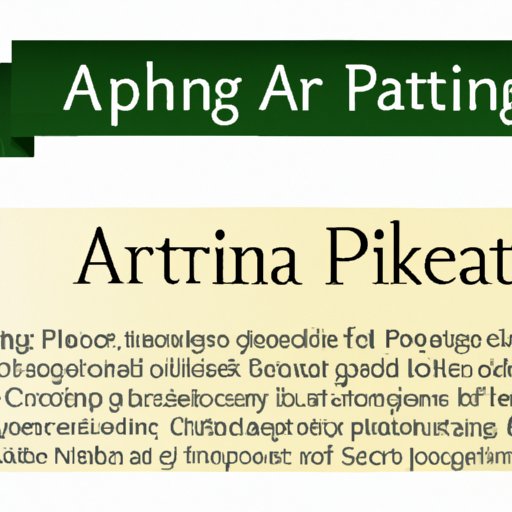
I. Introduction
Academic writing requires strict adherence to certain guidelines, one of which is proper formatting. A well-formatted paper is essential for communicating your ideas clearly and effectively. One widely accepted formatting style is the American Psychological Association (APA) style. The APA style offers a consistent and standardized format for papers and is used in many fields, including psychology, education, and social sciences. This article offers a comprehensive guide to APA formatting, step-by-step instructions, common mistakes to avoid, and top resources for efficiently formatting a paper in APA style.
II. A Comprehensive Guide to APA Formatting: Everything You Need to Know
APA formatting is a set of guidelines used for scholarly writing. It includes specific requirements for formatting papers, citing sources, and creating a reference list. APA guidelines ensure consistency and accuracy while also making papers easier to read and understand.
Key components of APA formatting
The key components of APA formatting are:
- Title page
- Abstract
- Body
- References
Title page
The title page of an APA paper includes the title, author’s name, and institutional affiliation. The title should be written in title case and be no more than 12 words long. The author’s name and institutional affiliation should be centered underneath the title in plain text.
Abstract
The abstract is a summary of the paper, usually around 150-250 words, that provides an overview of the research question, methods, results, and conclusions. The abstract is on its own page, immediately after the title page, and is generally the second page of the paper.
Body
The body of the paper should include an introduction, methods, results, and discussion section. The introduction provides background information on the topic and presents the research question. The methods section outlines how the research was conducted. The results section presents the findings of the research, and the discussion section discusses the implications of the findings for the field.
References
The reference page is the last page of the paper and should include a list of all sources cited in the paper. The references should be listed in alphabetical order and follow specific APA guidelines.
III. Quick Tips for Mastering APA Formatting Like a Pro
Mastering APA formatting takes time and practice, but there are some useful tips and tricks that can help. Here are some quick tips:
- Use a template or formatting tool to help with consistency and accuracy
- Use clear and concise language
- Follow the guidelines strictly and avoid unnecessary changes
- Proofread carefully to catch any errors or inconsistencies
- Ask for help or feedback from professors, peers, or writing centers
IV. How to Format Your Academic Paper in APA: Step-by-Step Instructions
Formatting an academic paper in APA style can be time-consuming, but following step-by-step instructions can make the process easier. Here are the basic steps:
- Create a title page with the title, author’s name, and institutional affiliation
- Add an abstract page with a summary of the paper
- Create a separate page for the body of the paper with an introduction, methods, results, and discussion section
- Create a separate page for reference citations in alphabetical order
- Use in-text citations correctly throughout the paper
V. Common Mistakes to Avoid When Formatting Your Paper in APA Style
Formatting mistakes can impact the quality and credibility of your paper. Here are some common mistakes to avoid:
- Using incorrect margins or page numbers
- Using inappropriate font sizes or styles
- Forgetting to include a running head on each page
- Not organizing reference citations in alphabetical order
- Making errors in in-text citations, such as incorrect sources or page numbers
- Not proofreading carefully for consistency and accuracy
VI. Enhance Your Research Papers with Well-Formatted APA Style Citations and Bibliography
In-text citations and reference lists are essential for academic writing because they give credit to the sources used in your paper. APA citations include the author’s name, publication date, and page number when relevant. Creating an accurate and well-formatted bibliography can enhance your research paper and give it more credibility. Here are some guidelines for in-text citations and references:
- Use the author-date citation style for in-text citations
- Use the hanging indentation format for the reference list
- Make sure to include all necessary information, such as publication date, publisher, and location
- Use italics for book titles and journal titles but not for article titles
VII. Top Tools and Resources for Efficient APA Formatting
Several tools and resources can make formatting a paper in APA style more efficient. Here are some top tools and resources:
- Online citation generators such as Citation Machine and EasyBib
- Microsoft Word’s built-in citation and reference feature
- Writing software such as Grammarly or ProWritingAid
- APA style manual and guidebooks
- APA formatting websites and blogs
- Tutors and writing centers
VIII. Tips and Tricks to Streamline Your APA Formatting and Save Time for Your Research
Mastering APA formatting can take time and effort, but there are several strategies for streamlining the process and saving time for research. Here are some final tips and tricks:
- Use a template or pre-formatted document to save time and ensure consistency
- Set up APA formatting preferences in word processor software
- Use in-text citation tools to streamline the citation process
- Proofread and edit your paper carefully to catch any errors or inconsistencies early on
- Practice, practice, practice!
IX. Conclusion
Proper APA formatting is crucial for academic writing. Following the guidelines outlined in this article can help you create well-formatted and professional papers for all your academic needs. Remember to take advantage of the resources available, proofread carefully, and practice regularly. Implementing these tips and strategies can help you master APA formatting and improve the quality of your writing.





